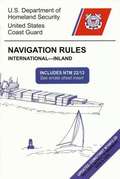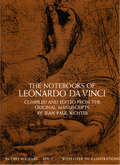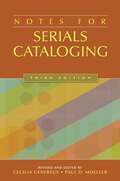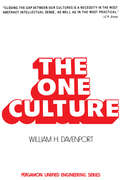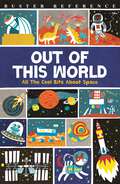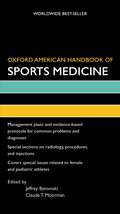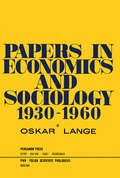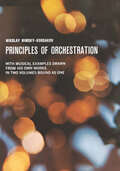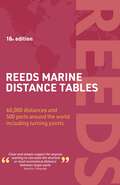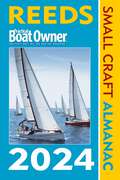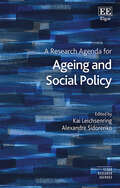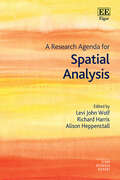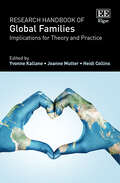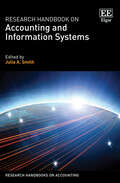- Table View
- List View
Navigation Rules for International and Inland Waters
by United States Coast GuardThis book contains a complete copy of the Inland and International Navigation Rules as presented by the United States Coast Guard. Paradise Cay Publications Inc. has added some additional features to the Government Edition to make the book more useful and comprehensive.
The Notebooks of Leonardo da Vinci, Vol. 1 (Dover Fine Art, History of Art #1)
by Leonardo Da VinciScientist, painter, mechanical engineer, sculptor, thinker, city planner, storyteller, musician, architect — Leonardo da Vinci, builder of the first flying machine, was one of the great universal geniuses of Western civilization. His voluminous notebooks, the great storehouse of his theories and discoveries, are presented here in 1566 extracts that reveal the full range of Leonardo's versatile interest: all the important writings on painting, sculpture, architecture, anatomy, astronomy, geography, topography, and other fields are included, in both Italian and English, with 186 plates of manuscript pages and many other drawings reproduced in facsimile size.The first volume, which contains all of Leonardo's writings on aspects of painting, includes discussions of such basic scientific areas as the structure of the eye and vision, perspective, the science of light and shade, the perspective of disappearance, theory of color, perspective of color, proportions and movements of the human figure, botany for painters, and the elements of landscape painting. A section on the practice of painting includes moral precepts for painters and writings on composition, materials, and the philosophy of art. The second volume contains writings on sculpture, architecture (plans for towns, streets, and canals, churches, palaces, castles, and villas, theoretical writings on arches, domes, fissures, etc.), zoology, physiology (including his amazingly accurate theories of blood circulation), medicine, astronomy, geography (including has famous writings and drawings on the movement of water), topography (observations in Italy, France, and other areas), naval warfare, swimming, theory of flying machines, mining, music, and other topics.A selection of philosophical maxims, morals, polemics, fables, jests, studies in the lives and habits of animals, tales, and prophecies display Leonardo's abilities as a writer and scholar. The second volume also contains some letters, personal records, inventories, and accounts, and concludes with Leonardo's will. The drawings include sketches and studies for some of Leonardo's greatest works of art — The Last Supper, the lost Battle of Anghiari, The Virgin of the Rocks, and the destroyed Sforza monument.
Notes for Serials Cataloging
The last decade has brought a great deal of change to serials and to scholarly communication as a whole. Serials have gone online or online only with a rapidness few expected; and many libraries now spend half or more of their materials budgets on electronic journals. Arranged in MARC tag order and by topical subdivision, the latest edition of Notes for Serials Cataloging is designed to help both novice and experienced serials catalogers describe the complex characteristics and relationships of serial publications and construct clear and concise notes. In addition to updated definitions, scope notes, and examples of notes presented in previous editions, it incorporates notes used in electronic serials cataloging as well as covers changing practices in MARC note field usage in keeping with CONSER standards.
Œuvres complètes de Voltaire: Questions sur l'Encyclopedie, par des amateurs (III): Aristote-Certain (Œuvres complètes de Voltaire (Complete Works of Voltaire) #39)
by VoltairePart of the complete works of the French philosopher, historian and social reformer, Voltaire. Addresses a broad range of subjects in religion, history, art and literature. Voltaire's longest text and neglected masterpiece. For students and scholars of the 18th-century Enlightenment.
Œuvres complètes de Voltaire: Questions sur l'Encyclopedie, par des amateurs (VII): Langues-Prieres (Œuvres complètes de Voltaire (Complete Works of Voltaire) #42B)
by VoltairePart of the complete works of the French philosopher, historian and social reformer, Voltaire. Addresses a broad range of subjects in religion, history, art and literature. Voltaire's longest text and neglected masterpiece. For students and scholars of the 18th-century Enlightenment.
The One Culture
by William H. DavenportThe One Culture focuses on the state of the American culture in the so-called Age of Technology. This book is composed of four chapters that consider the influence of humanities and social sciences in engineering education. The opening chapter focuses on the famous two cultures’ assertion that art and science do not mix. This chapter deals with the problems of definition, semantics, image, and attitude in this assertion. The succeeding chapter examines the typical contemporary “confrontation" between art, literature, and technology. A chapter describes the connecting link between the fields of humanities, social sciences, and engineering. The final chapter looks into the prospect of order, design, and unity as a counter-argument to a negative, self-destroying dualism. This book will prove useful to humanists, engineers, social scientists, and students who are interested in human culture.
Out of This World: All The Cool Bits About Space
by Clive GiffordOut Of This World is jam-packed with everything children need to know about space - from facts and statistics to real-life adventures. Boys and girls can find their way around the solar system, learn if aliens really could exist and discover the origins of the universe. Entertaining and educational, this learning companion would make the perfect addition to any school child's bookshelf.
The Oxford Handbook of Radio and Podcasting (Oxford Handbooks)
Radio today remains the most accessible and widely available communication medium worldwide, despite technological shifts and a host of upstart challengers. Since its origins in the 1920s, radio has innovated a new world of sound culture - now expanded into the digital realm of podcasting that is enabling the medium to reach larger audiences than ever before. Yet radio remains one of the least studied of the major areas of communication arts, due largely to its broadcast-era ephemerality. With the advent of digital technology, radio's past has been unlocked and soundwork is exploding as a creative field, creating a lively and diverse sonic present while simultaneously making critical historical analysis possible at last. This volume offers newly commissioned chapters giving readers a wide-ranging view of current critical work in the fields of radio and podcasting, employing specific case studies to analyze sound media's engagement with the arts; with the factual world of news, talk, and documentary programming; as a primary means of forging community along with national, transnational, and alternative identities; and as a subject of academic and critical research. Its historical scope extends from radio's earliest days, through its mid-twentieth century decades as the powerful voice of nations and empires, onto its transformation into a secondary medium during the television era, and into the expanding digital present. Over the course of 37 chapters, it provides evidence of the sound media's flexibility and adaptation across diverse cultures by examining radio's past and present uses in regions including the United States, Canada, Britain, Australia, Poland, China, Korea, Kenya, Angola and Mozambique, South Asia, and the Caribbean. Contributors include historians and media scholars as well as sound artists and radio/podcast producers. Notably, companion links to digital ?quotations? from works analyzed are included in many chapters along with chapter audiographies offering links to further listening. Throughout, The Oxford Handbook of Radio and Podcasting connects radio's broadcast past to its digital present, and traces themes of creativity, identity, community, nation, and transnationality across more than a century of audio media.
Papers in Economics and Sociology
by Oskar LangePapers in Economics and Sociology is a compilation of materials authored by the Polish economist Oskar Lange. The coverage of the essays covers the interrelations between economic and social issues. The text first covers the Marxist and socialist theory, and then proceeds to tackling political economy and socialism. Next, the selection deals with economic theory, along with the mathematical models, econometrics, and statistics utilized in economic analysis. The text also covers the economic science in the service of practice. The book will be of great use to political scientists, sociologists, behavioral scientists, and economists.
The Phenomenon of Architecture in Cultures in Change
by David OakleyThe Phenomenon of Architecture in Cultures in Change focuses on the study of architectural design and its impact in the developing world. The book first elaborates on architectural function and problems and building problems. Discussions focus on a unified form of classification to characterize building context, architecture and society, development process and the building process, understanding of architectural form, and exploring architecture. The text then ponders on economy, intentions, ideas, and method in design. Topics include method in design work, formal articulation and architectural expression, synthesis of critical approaches, architectural ideas, search for system in design work, and economy and the design process. The manuscript examines education and architecture and community, as well as urbanizing rural region, residential urban renewal, and town design service. The book is a dependable source of data for architects and researchers interested in the phenomenon of architecture.
Principles of Orchestration
by Nikolai Rimsky-Korsakov"To orchestrate is to create, and this cannot be taught," wrote Nikolay Rimsky-Korsakov, the great Russian composer whose genius for brilliant, highly colored orchestration is unsurpassed. But invention, in all art, is closely allied to technique, and technique can be taught. This book, therefore, which differs from most other texts on the subject because of its tremendous wealth of musical examples and its systematic arrangement of material according to each constituent of the orchestra, will undoubtedly be of value to any music student. It is a music classic, perhaps the only book on classical orchestration written by a major composer.In it, the composer aims to provide the reader with the fundamental principles of modern orchestration from the standpoint of brilliance and imagination, and he devotes considerable space to the study of tonal resonance and orchestral combination. In his course, he demonstrates such things as how to produce a good-sounding chord of certain tone-quality, uniformly distributed; how to detach a melody from its harmonic setting; correct progression of parts; and other similar problems.The first chapter is a general review of orchestral groups, with an instrument-by-instrument breakdown and material on such technical questions as fingering, range, emission of sound, etc. There follows two chapters on melody and harmony in strings, winds, brasses, and combined groups. Chapter IV, Composition of the Orchestra, covers different ways of orchestrating the same music; effects that can be achieved with full tutti; tutti in winds, tutti pizzicato, soli in the strings, etc.; chords; progressions; and so on. The last two chapters deal with opera and include discussion of solo and choral accompaniment, instruments on stage or in the wings, technical terms, soloists (range, register, vocalization, vowels, etc.), voices in combination, and choral singing. Immediately following this text are some 330 pages of musical examples drawn from "Sheherazade," the "Antar Symphony," "Capriccio Espagnol," "Sadko," "Ivan the Terrible," "Le Coq d'Or," "Mlada," "The Tsar's Bride," and others of Rimsky-Korsakov's works. These excerpts are all referred to in the text itself, where they illustrate, far better than words, particular points of theory and actual musical practice. They are largely responsible for making this book the very special (and very useful) publication it is.This single-volume edition also includes a brief preface by the editor and extracts from Rimsky-Korsakov's 1891 draft and final versions of his own preface, as well as an appendixed chart of single tutti chords in the composer's works.
Psychological Foundations of Education: Learning and Teaching
by B. Claude Mathis John W. Cotton Lee SechrestPsychological Foundations of Education presents some of the principles of psychology that are relevant to learning and teaching. It presents an alternative answer to the problem of the bifurcation of general and educational psychology in the curriculum of teacher preparation. While the solution is provisional and has obvious imperfections, it is offered in the hope that it may stimulate discussion of the problem and other solutions and/or explicit justifications for past practice. Key concepts discussed include teachers’ attitudes and behavior, different types of learning, technology in education, forgetting and extinction, child development, and intelligence measurements. Also covered are the assessment of educational achievement, the social psychology of the classroom, and education in urban schools. This text should have a variety of uses in classes where students are preparing for teaching. It was written specifically for those situations in which the prospective teacher is introduced to psychology through a one- or two-semester integrated sequence.
Recollections and Letters of General Lee
by Robert E. LeeBiography of the famous general by his son
Recollections and Letters of General Robert E. Lee
by Robert E. LeeGeneral Robert E. Lee was the most heroic figure of the Civil War, but to many, he is a solitary figure. This book fleshes out the man and reveals the workings of a great military mind and a warm, understanding, and generous human being. It shows all the facets of the general during the war; at the conclusion, when he was an outspoken proponent of a reasonable peace which would allow the South to rejoin the Union; and after the war, when he served as president of Washington College, and became a driving force for the creation of a viable educational system. This anthology shows all these facets of the general, through his correspondence and through the revealing insight supplied by his son. No other collection of source materials gives such a whole and rewarding picture of one of the South's greatest sons and heroes.
Reeds Marine Distance Tables 18th edition
by Miranda Delmar-Morgan Kendall CarterReeds Marine Distance Tables are the perfect ready-reckoner for captains, navigators and owners of merchant and cruise ships large and small wanting a quick and accurate distance reference between all the regularly used commercial ports around the world. They are also of increasing value to the superyacht fleet.The book is divided into key 'market areas', and includes a pull-out map for area identification and easy see-at-a-glance port reference. Traffic Separation Schemes are calculated into the tables whilst the distance to any port not included can easily be determined by making an approximation from the next closest port. Useful tables of major 'turning points' around the world (such as Cape Finisterre, Cape Horn and the Dover Straits), Transatlantic distances, world time zones, and time and speed conversion tables are also included.As well as incorporating general updates and improvements, this edition has been expanded to include more Indian Ocean ports, routes reflecting the increasing role of China in international shipping, as well as inter-distance tables for the Adriatic and Aegean. Freighter movements, cargo tonnage and cruise ship destinations have all been factored into considering details on the top ten busiest ports worldwide.Reeds Marine Distance Tables are an invaluable reference for ship owners, operators, brokers, navigators and superyacht skippers. Using this one reference, anyone can calculate the shortest or most economical distances between all the major ports in the world.
Reeds PBO Small Craft Almanac 2024 (Reed's Almanac)
by Perrin Towler Mark FishwickIn a practical handy format the Reeds PBO Small Craft Almanac, published in association with Practical Boat Owner, covers all of the UK and Ireland, as well as the North Atlantic coastline from Denmark to the Gironde.The Reeds PBO Small Craft Almanac may be more compact and concise than the Reeds Nautical Almanac but it contains a wealth of indispensable navigational data specially tailored for small craft sailors, presented in an easy-to-find, quick-reference manner for on-board use. Streamlined to focus on tidal data (tide tables, tidal streams and tidal curves) and lights, buoys and waypoints, the Small Craft Almanac covers the whole of the UK and Ireland and the west coast of Europe from Denmark to the Gironde.Published in association with Practical Boat Owner magazine, this practical handy Almanac boasts many unique features for small craft sailors and represents excellent value for money for those who don't need the more comprehensive marina data, passage information and chartlets of the full Reeds Almanac.Meticulously researched, it includes a huge amount of information of value to small craft navigators: tide tables, tidal streams and tidal gates; secondary port differences; 2,500+ waypoints; radio data; light recognition; weather information; principal lights; IALA buoyage; international codes and flags; sun/moon rise/set times; emergency information.Also available: free supplements of up-to-date navigation changes from January to June at: www.reedsnauticalalmanac.co.uk
A Research Agenda for Ageing and Social Policy (Elgar Research Agendas)
Elgar Research Agendas outline the future of research in a given area. Leading scholars are given the space to explore their subject in provocative ways, and map out the potential directions of travel. They are relevant but also visionary.Written by a global collective of scholars from a wide variety of backgrounds, including health studies, psychology and economics as well as social policy and gerontology, this timely Research Agenda highlights the challenges and opportunities of rising longevity and population ageing for social policy providing clear directions for future research.Divided into five comprehensive parts, this Research Agenda examines research priorities from policy perspectives, the role of social policy research in relation to intergovernmental organisations, and the framework for future-oriented social policies on ageing provided by a life-course approach. It demonstrates that social policy experts must evaluate interests and expectations both qualitatively and quantitatively, and asserts that future research on social policy and ageing will be inspired by a broad range of stakeholders, including non-governmental interest organisations and state actors.A Research Agenda for Ageing and Social Policy will be enlightening for students and researchers focusing on social policy, ageing, development, health policy and inequality. It will also be a fascinating read for practitioners seeking a wider understanding of social policy priorities and processes.
A Research Agenda for Organizational Ethics (Elgar Research Agendas)
Elgar Research Agendas outline the future of research in a given area. Leading scholars are given the space to explore their subject in provocative ways, and map out the potential directions of travel. They are relevant but also visionary.Drawing on the philosophy of existentialism, this thought-provoking Research Agenda questions and encourages deeper ethical thinking about organizational practices during this time of existential crisis. Rather than relying on prescriptive normative ethical theories, it advocates for ethical concerns to be addressed through intersubjective encounters.Chapters engage with diverse philosophical perspectives and illuminate their key ideas through literature, visual arts, and music, bringing forth situated truths that will resonate with and incite the reader to think and act critically to avoid perpetuating dehumanization, precarity, and mindlessness. The Research Agenda will ultimately inspire leaders and scholars to expand, rethink, practice, sustain, and transform organizations towards a future of flourishing for all stakeholders.Integrating qualitative hermeneutics with existential philosophy, this discerning Research Agenda will offer students and scholars of organization studies, business ethics and leadership a unique perspective on organizational ethics.
A Research Agenda for Spatial Analysis (Elgar Research Agendas)
Elgar Research Agendas outline the future of research in a given area. Leading scholars are given the space to explore their subject in provocative ways, and map out the potential directions of travel. They are relevant but also visionary.This Research Agenda explores the future of spatial analysis, and how the field informs and challenges the policy landscape. A wide range of contributors from different intellectual communities address the problem of causality in geographic analysis, arguing that diversity is crucial for the future success of the discipline.Chapters define and explore specific concepts and practices within the field, for instance data science and geosimulation, providing perspectives on the current state of the art of these areas within geography, and how they will shift in the future. In the first section, contributors cover the fundamentals of the topic, as well as various ways to handle the ‘spatial variable’, including the concept of space, the scale of spatial patterns and what those patterns reveal. The book then analyses schools of practice, including geographical data science, causality, generative modelling and machine learning.A Research Agenda for Spatial Analysis will prove an invaluable resource for spatial analysts and geographic information scientists interested in learning about the direction of future developments in the field. Additionally, scholars and students of human and urban geography and geographic research methods will benefit from this crucial overview of the topic.
Research Handbook of Children and Armed Conflict
The Research Handbook of Children and Armed Conflict adeptly explores children’s lived realities of armed conflict and its aftermath. Featuring empirical, conceptual and policy analyses, alongside moving first-hand accounts of the experiences of war-affected children and youth, it highlights the urgent need for advocacy and action on this issue.Boasting state of the art contributions by eminent scholars and practitioners from across the globe, this Research Handbook explores the theoretical, practical, and policy issues related to children affected by war. Chapters investigate the profound harms experienced by such children and youth, whether in the heat of conflict, during flight or during resettlement to a new context, underscoring the urgency and high stakes of these situations for children and families affected by war. The Handbook demonstrates that scholarly discussions and debates must ultimately contribute to real-life changes to promote more just and effective immigration legislation, policies, programmes, and practices for war-affected children.Integrating conceptual analyses with concrete policy and political engagement, this incisive Research Handbook will prove essential for scholars, researchers, and students interested in war studies, security, refugee studies, forced migration, international development, child protection and post-conflict reconstruction. Its policy and legally-oriented chapters will also benefit policymakers, civil servants and international NGOs.
Research Handbook of Global Families: Implications for Theory and Practice (Research Handbooks in Business and Management series)
With research into the lives of global families becoming an increasing focus worldwide, this Research Handbook is a timely compendium of contemporary scholarship. It aptly describes the work-family interface, delving into the unique dimensions of global family life. This carefully designed Research Handbook offers a resource of nuanced discussions on some familiar topics as well as often-overlooked topics including global rainbow families, expatriate children and FIFO family life. While providing an essential theoretical understanding, each chapter also offers clear agendas for future research with theoretical insight. With a focus on insider perspectives, it successfully frames today’s family challenges in a clear and concise way. The Research Handbook of Global Families will be useful for students and academics of such disciplines as global politics, human resource management, migration theory and sociology. It will also be an important reference point for researchers seeking up-to-date information about the nature of global family life.
Research Handbook on Accounting and Information Systems (Research Handbooks on Accounting series)
The role of the accountant is changing, as developments in technology alter the ways in which information is prepared and analysed. This Research Handbook addresses the use of both financial and non-financial information for planning, decision-making and control in organisations. Written by experts in the field, the book uses comprehensive literature reviews, empirical fieldwork and theoretical developments to provide an overview of research in this important area. It includes the following:Information for controlling and managing behaviour and performanceNovel and contemporary fieldwork studies that explore the use of accounting and informationThe use of accounting and non-accounting information to support managerial and investment decisionsLiterature reviews on accounting and information systems, including on Cloud computing and Artificial Intelligence (AI)Technological developments, the use of AI and concerns over the future of the accounting professionPlanning and design in information system research, including work on Enterprise Resource Planning (ERP) systemsComprehensive in scope, the Research Handbook on Accounting and Information Systems will be indispensable for researchers, academics and students of accounting, information systems, economics and finance, business and management, and innovation and technology. Business managers and accountants will also be able to apply it to their own professions.
